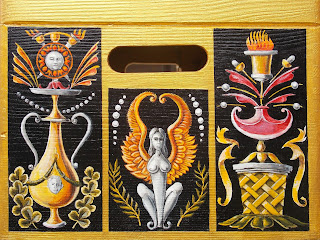My Feast Box
Feasting at the SCA is an important part of the experience, and we try to do it in a reasonably authentic way, using cutlery, crockery and other table-ware appropriate to the period. Thus the "Feast Box" is an important part of anybody's kit, a means of conveying all the necessaries for participating in a feast. Such boxes need to be identifiable as there are many participants at a feast, so Mary encouraged me to paint my coat of arms on mine (such personal heraldry as an important part of SCA culture). I did, and went a bit overboard. As I entered the box in an "Arts and Sciences" competition, I included the following documentation.
Painted Feast Box
Richard of Salesberie
15th Century “Cassoni”.
This project was never intended to be a re-creation of an
authentic-looking Period artefact, but rather to decorate a functional item
that I use at SCA events in a manner that recalls elements of period
design. The box itself especially makes
no pretence to authenticity… it is an off-the-shelf item from B&Q. The
decorative motifs which I have used come from two sources: a late 15th
century illuminated book, and a late 15th century glazed plate, both
of Italian origin, and neither anything to do with boxes. I therefore make no
claim to represent an authentic-looking box of the era.
That said, the painted wooden chest was an established genre in late 15th
century Italy. Some fine examples exist,
so much so that a number of the “paintings” in the National Gallery and
equivalent prestigious collections are in fact panels from dismantled wooden
chests. These boxes are called “Cassoni” (singular “Cassone”) and were often
created to mark a wedding. Common motifs
would be the coats of arms of the couple and scenes from mythology… so in fact,
my chest, which includes my arms and a panel showing the birth of Venus
(probably… see below), is not so far wrong.
Example of a 15th
Century Florentine Cassone from the Victoria and Albert Museum. Note panel showing classical imagery and
gilded surround, elements found in my feast box.
Painted panel from c 1445 showing
David in triumph by Francesco Passelino, originally from a Cassone, now
displayed in the National Gallery.
Milanese Book illumination
motifs.
I have rearranged the motifs from the manuscript page as required for
my purposes to fit onto the box. The lid
is based on the lower panel (with the arms changed to my SCA arms).
The front combines the top panel with the illuminated letter (changed
from “N” to “R”) and lettering based on
the beautiful humanist hand used in this manuscript. The inscription on the box was made
deliberately lengthy to allow this lettering to be used.
The box sides use the
decorative motifs from the side panels of the manuscript page, in each case
divided up into three sections placed side by side, because of the constraints
of the proportions of the box. All
drawing was freehand copy.
Majolica Plate motif.
The material from the Milanese manuscript gave me enough to decorate the top
and three sides of the box, but that left the back still undecorated. Inspired by the “cassoni” described earlier,
I decided to go for a full-sized panel with a mythological motif. I had shortly before photographed a majolica
plate in the Victoria and Albert museum that I had thought might be the basis
for a painted plate of my own, but decided instead to use it as the basis for
the missing panel, since its aquatic theme tied in with the merman and dolphin
motifs that I had used elsewhere on the box.
I regret that I did not make notes on the provenance of the plate, but I
believe we are again dealing with late 15th century Italian work.
I am not certain what the plate depicts. The naked figure on the seashell immediately suggests
the famous image of the birth of Venus, best known as depicted by
Botticelli. But elements of the scene
(the fact that the seashell is borne by dolphins, the surrounding
horse-tritons, the cloaks and Cupid flying overhead) are all absent from that
image but found in Raphael’s “Triumph of Galatea”. See below for comparison.
Adapting the image from the plate to the box was obviously not
straightforward, since the one is circular and the other rectangular. Moreover, the colours available in glaze and
the techniques used to paint with them place constraints on the plate decorator
that don’t apply to a painter on a wooden panel. I wasn’t aiming to make my box look like
glazed ceramic: I wanted it to look something like the tempera painted panels
of which a “Cassone” is constructed. So
though I took motifs and the overall composition from the plate, and to some
degree the colours, I copied freely and adapted as necessary for my
purposes. Here is the end result:
Materials
No attempt was made to use period materials: the priority was to
produce something that would look attractive but be robust enough to endure the
sort of treatment a feast box must endure.
The box itself is plywood and an off-the-shelf item from B&Q. It was undercoated with a water-based acrylic
primer/undercoat, and painted with acrylics.
The gold bordering is acrylic metallic paint. The whole thing was finished by spraying it
with a considerable number of coats of acrylic gloss varnish for protection,
and thus far it has done the trick… the box still looks good despite having
attended several events.
An original “Cassone” of this period would probably have been painted
in tempera (though oil painting was just coming in around the end of the 15th
century) and decorated with gilded gesso.
Artists of the day had access to a wide range of pigments and a
sophisticated understanding of how to mix them, so there were in effect no
colours that I have used that would have been unavailable to them.















Comments
Post a Comment